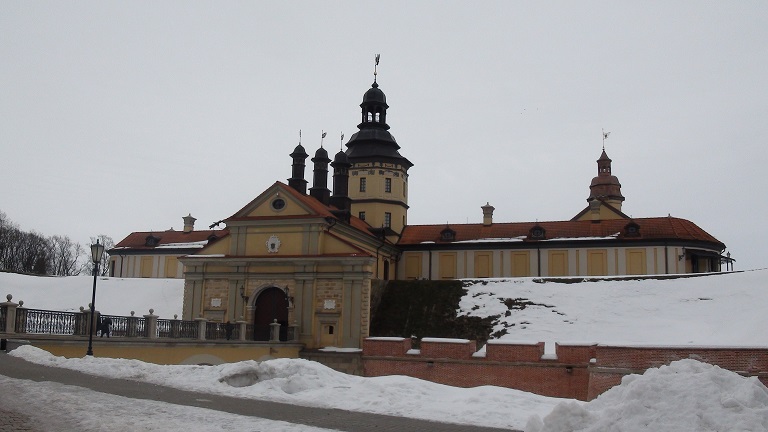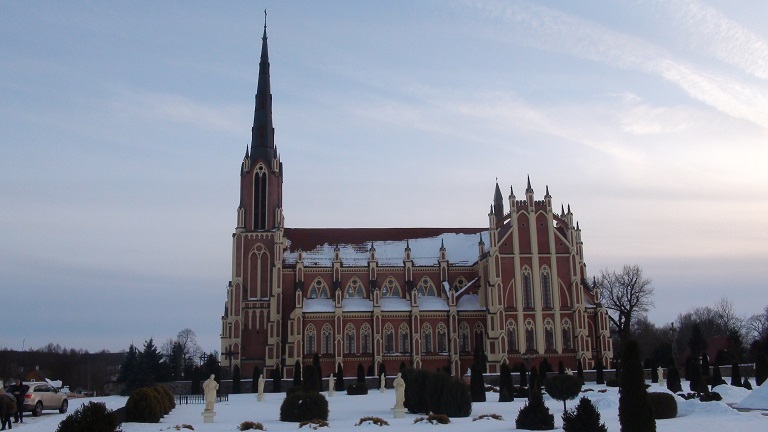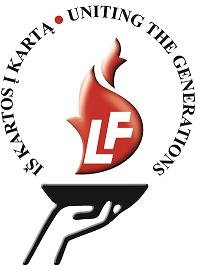Belarus
Belarus and Lithuania are neighboring countries joined by united medieval history. Since its inception in the 13th century, the Grand Duchy of Lithuania expanded to Slavic lands absorbing entire modern-day Belarus and ruling it until the Grand Duchy's demise in 1795.
Lithuanian nobility families (with powers higher than those of the King) had manors and palaces both in modern-day Lithuania and Belarus. Belarus also had a fair share of castles that defended the Grand Duchy from Teutonic, Mongol, Rusian and Swedish invasions. The majority of such magnificent buildings are located near the Lithuania's capital city Vilnius. Vilnius is located merely 30 km from Lithuanian-Belarusian boundary meaning that much of Grand Duchy heritage is left "on the other side". Some of these 14th-18th-century buildings are completely rebuilt while others remain as romantic ruins.
Most famous among them are the Mir (Myras) castle and Nesvizh (Nesvyžius) Palace, both rebuilt and recognized as World Heritage by UNESCO.

Nesvyžius (Nesvizh) palace from the outside. ©Augustinas Žemaitis.
Ruzhany (Ružanai) Palace and Lida (Lyda) Castle are undergoing renovations. Atmospheric ruins at Golshiany (Alšėnai) still evoke memories of distant past while Kreva (Krėva) and Navahrudak (Naugardukas) defensive castles are ruined more. In Hrodna (Gardinas) two castles have been repurposed by Soviets and even used as workshops.
A multitude of old small Catholic and Orthodox churches and monasteries of the region also dates to the Grand Duchy of Lithuania era. They are Gothic or Baroque (the local form of Baroque is known as Vilnius Baroque and even the Cathedral of Belarusian capital Minsk is an example of this style). Orthodox churches here are similar in style to Catholic ones without the iconic domes.
Prior to the 19th century the areas where most Lithuanian castles and palaces stand had a Lithuanian-speaking peasant majority. However, this did not survive the onslaughts of Russian Imperial and Soviet russification. Currently, only some villages remain Lithuanian. The linguistic switch did not erode some other distinctive cultural traits: the borderland remains Catholic-majority (other Belarusians are largely Orthodox).

Map of Lithuanian castles in Belarus and southeastern Lithuania. ©Augustinas Žemaitis.
Grand Duchy of Lithuania castles and palaces in Belarus
Castles and palaces of Lithuanian Grand Duchy in Belarus are located within 100 km from the modern Lithuanian-Belarusian boundary. They were constructed in the during the golden eras of the Duchy (14th-17th centuries). During 19th-20th centuries (after the Duchy fell) these magnificent buildings were neglected and even scavenged for bricks. After 1991 independence Belarus started rebuilding them (not fully authentically).


Ružanai (Ruzhany) palace undergoing reconstruction. The neglected wing is visible through a restored gate. ©Augustinas Žemaitis.
Grand Duchy of Lithuania is regarded by some Belarusian historians to be the source of Belarusian statehood. There are even interpretations claiming that the Duchy was more Belarusian than Lithuanian. This is however not true as the ruling nobility was mainly of Lithuanian origin, while demography (after the Union of Lublin) was 46% Lithuanian and 40% Belarusian. However, the medieval Lithuania was a very tolerant society for its era. It had been united by largely peaceful means and the 1529 Statute equalized rights of Orthodox Belarusians with those of Catholic Lithuanians.
The first emblem Belarus adopted after its independence was the Lithuanian Vytis (albeit in slightly different colors). Contemporary Belarusian flag (white-red-white) was also based on Vytis (unlike the modern Lithuanian tricolor which is criticized by some heraldry experts for breaking with heraldic tradition). These symbols are still used by opposition alone as after A. Lukashenko came to power in 1995 he switched back to modified Soviet symbols as he associates Belarus more with the Soviet history rather than the medieval one.
Lithuanian castles and manors near Minsk-Brest highway
You may see some of the most magnificent Lithuanian castles along the Minsk-Brest route.
Arguably the most famous among them is Myras (Mir) Castle. Part of UNESCO heritage it was completely rebuilt by ~1995. Initially constructed by Jurgis Iljiničius (George Ilyinich) in late 15th century (gothic style) it was subsequently expanded by the famous Radvila (Radziwill) family (16th century, Rennaisance style). Back then only the richest could have owned a brick castle. A museum is now located inside.


Myras (Mir) castle in the evening. ©Augustinas Žemaitis.
One of the major Radvila family residences is located some 30 km south. This is the fortified Nesvyžius (Nesvizh) Palace commisioned in 1582. Together with Sapiegas, Radvilas were one of the most influential Lithuanian families.
Nesvyžius palace (crowned by a tall tower and joined by a lush park) was a gem of the Radvilas and in turn a gem of the Grand Duchy‘s famous manor culture. Rebuilt in 2010 it houses a modern museum with English inscriptions, computer displays and historical re-enactments (something rare in Belarus). The nearby Nesvyžius town has little authenticity in it as it faced destruction (like most Belarusian towns). However the Radvila-funded world‘s second-oldest Baroque church (after Gesu in Rome) survives while a towered city hall was recently rebuilt.


Opulent courtyard of Nesvizh (Nesvyžius) palace. ©Augustinas Žemaitis.
Naugardukas (Navahrudak) town has a Glastonbury-like atmosphere with Tor replaced by castle ruins on the Mindaugas Hill. Castle has been developed by Grand Duke Vytautas and his successors (14th-16th centuries). The lower town has Grand Duchy churches and even a Tatar mosque signifying the multicultural population of the former Duchy. Stryjkowski chronicle claims that Naugardukas was Grand Duchy’s capital prior to Vilnius but this is unsubstantiated by any other historical documents.


Naugardukas (Navahrudak) castle ruins (left) and one of its old small churches (right). ©Augustinas Žemaitis.
Ružanai (Ruzhany) houses an extensive 18th century Sapiega family palace. The front part that includes gate is rebuilt but the entire horseshoe-shaped arcaded courtyard buildings are ruined. The inspiring former lavishness may still be felt however.


Some of the buildings that surround Ružanai (Ruzhany) palace courtyard. ©Augustinas Žemaitis.
Kosava (some 15 km north of Ružanai) is the birthplace of Tadeusz Kościuszko (Tadas Kosciuška), a Polish-Lithuanian military officer (1746-1817) who reached intercontinental fame as he fought for independence of his homeland, helped USA win freedom and even the tallest Australia’s mountain is named after him. A restored wooden hut marks his birthplace. From this hut one may see a Turkish-inspired palace of Wandalin Puslowski nearby (ruined, under restoration) but it dates to the post-Lithuanian era (1831).
Lithuanian castles and manors near the Lithuanian border
South of modern day Lithuania there are two large cities of Hrodna (Gardinas; pop. 300 000) and Lida (Lyda; pop. 100 000). Lida was part of Lithuanian-inhabitted core of the Duchy while Hrodna marked its limits. Both cities were defended by might castles.
Rectangular Lyda (Lida) Castle (built by Grand Duke Gediminas in the 14th century) defended by two towers was built in plains rather than on a hill. Now rebuilt its courtyard houses various events. In medieval eras it housed expelled khans of the Mongol Golden Horde.


Gediminas Castle in Lida. ©Augustinas Žemaitis.
Hrodna (Gardinas) has two castles, both located next to each other on twin hils at banks of river Nemunas. The Old Castle has been constructed by Grand Duke Vytautas the Great whereas the palace-like New Castle dates to 17th century. Their interiors were destroyed by Soviets (Old Castle now houses wood worksops). Between the castles a Lithuanian-funded wooden sculpture of Vytautas is located, one of merely few statues for Grand Duchy-era luminaries in Belarus.


The Old Castle of Hrodna and Vytautas the Great statue. ©Augustinas Žemaitis.
Merely some 50 km east of Vilnius, just beyond Medininkai border control point there are remains of two once-glorious castles: Alšėnai (Golshiany) and Krėva (Kreva). Alšėnai was yet another residence of the Sapiegas. The remaining ruined part is not completely destroyed as you may still see former internal walls and filled cellars (and imagine the magnificient past).


The remains of Alšėnai Castle. ©Augustinas Žemaitis.
Few Lithuanian castles could outdo Krėva (Kreva) in historical importance. It was the location of 1385 Union of Krewo that made Lithuanian Jogaila also a Polish king (known there as Jagiello) and tied the histories of both nations for upcoming five centuries. Additionally it is likely that Grand Duke Kęstutis had been previously murdered in Krėva by Jogaila’s conspirators. Currently however Krėva is ruined. The rectangular walls are destroyed in places and only the lower part of rectangular towers remain intact.
A map of Lithuanian castles and palaces in Belarus is available here
Lithuanian-majority areas of Belarus
Prior to the 19th century, the entire castle-rich Belarusian-Lithuanian frontier was inhabited by an ethnic Lithuanian majority. Historically the Lithuanian nation was dominant in a far larger territory than the modern-day Republic of Lithuania. This is still visible in placenames: a lot of them in northwestern Belarus are of Lithuanian origin (the endings are Slavicised: Trakeli, Lazdūny, Kiemeliški, Gulbiny, Kiškeliški...). The letters "išk" ("ishk", "iszk") are unique to Lithuanian-origin placenames.
Lithuanians of the region assimilated into Slavic communities during the Russian Imperial and Soviet onslaughts of russification. Russian Empire banned the Lithuanian language in the mid-19th century and while the people of western Lithuania found it easier to illegally import Lithuanian books from Germany this was not the case in modern-day Belarus. The percentage of Lithuanian native speakers in Vilnius governorate (which included much of modern-day Belarus) decreased from 35%-40% in the mid-19th century to 17%-20% in ~1914. After a short Lithuanian rule, the region was captured by Poles in 1920 and the ongoing Polish-Lithuanian conflict over Vilnius led to further discrimination of the minority. The final blow was, however, the Soviet policies. Many Lithuanian majority areas were added to Soviet Belarus instead of Soviet Lithuania, all Lithuanian schools were then closed and even public speaking in Lithuanian prosecuted. In this era many Lithuanians left for Lithuania, others adopted the Russian language.
Several territories still contain Lithuanian communities. The largest of them is around Gerviaty (Gervėčiai) village (~14 villages, 9 of them Lithuanian-majority). Some 1000 Lithuanians live there today. A Lithuanian cultural center and Lithuania-funded Lithuanian school (Rimdžiūnai village) are at the heart of the community. While the older generations associate themselves with Lithuania, the kids rarely speak Lithuanian natively. The choice of whether to send them to Lithuanian or Belarusian school typically depends on the future their parents expect for them. The Lithuanian school even has some Belarusian students who are being prepared by their families for emigration to richer Lithuania. In Mykoliškės (Michailiški) village near Gerviaty (Gervėčiai) a new Astravec Nuclear Power Plant has been built. Its workers are brought in by Russia and some Lithuanian-owned homes were demolished to make a place for new constructions.
The most impressive building in Gervėčiai area is the gothic revival Gervėčiai church (1903). Lithuanian in style and massive size (62 m tall tower) it outflanks the 600-strong village. In fact, it is the largest Catholic church in Belarus and is still adorned by Lithuanian inscriptions and surrounded by tall elaborate Lithuanian wooden crosses (Lithuanian art of crossmaking is an immaterial UNESCO World Heritage).


The massive Gervėčiai church. ©Augustinas Žemaitis.
Other Lithuanian majority areas that survived until the Soviet occupation (1939) now are decimated. These are the villages around Varanavas, Pelesa, Apsas, Lazdūnai.
Pelesa still hosts a Lithuanian-language school funded by the Lithuanian government. In 2010, a wooden sculpture for Lithuanian Grand Duke Vytautas the Great was erected near the Catholic church of Pelesa (sculptor Algimantas Sakalauskas).
Even those regions where the Lithuanian language is no longer spoken at all still are distinctive from the rest of Belarus. The Catholic religion dominates there instead of Russian Orthodoxy, some Lithuanian traditions also survive.


Lithuanian crosses near the Gervėčiai church. ©Augustinas Žemaitis.
In addition to the centuries-old aforementioned communities, the 19th century Russian Imperial occupation led to the creation of new Lithuanian communities even in the eastern Belarus. With no limits on internal migration, some Lithuanian peasants left for eastern Belarus to establish Lithuanian villages such as Malkava (now Malkovka). Unfortunately, the Soviet deportations and russification totally uprooted these communities.





